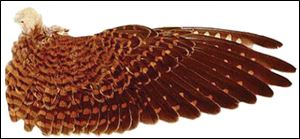
Outdoors Page: Light as a feather
5/31/2009
Hovering is very tiring and few birds can do it for long. The kestrel is an exception; it hovers while spotting prey. It needs a slight head wind to help keep it hovering.
If flight was so easy to achieve, all we would have to do is strap on a pair of wings and start flapping, much like the serious if comically naive attempts by various inventors at the turn of the 20th century.
No, flight for most of history was the domain of the bird kingdom, and its members have evolved a miraculous package of adaptations that work in wondrous synch to achieve the dream.
Birds can do what man has only been able to do in the last 100 years, said Dr. Susan Orosz, a Toledo veterinarian and internationally regarded authority on bird anatomy. They can fly very high they can see the curvature of the Earth. They can dive deep in the water. When you think about it they are so capable.
The bar-headed goose of Asia, for example, can migrate over the Himalayas, the tallest mountains of the planet. And penguins, though flightless in air, can fly undersea on their steering wings like a submarine.
All of which, Dr. Orosz notes, is why people are interested in birds. It s about the miracle of flight and what s behind it.
The most obvious structure is the wing, which has differing designs to serve varying flight patterns needed among the classes of birds. But, the veterinarian points out, the basic structure is the same muscle, bones, nerves are located in the same places anatomically. It s the shape of the wing that varies.
Beyond the wing is a unique cardiovascular system, with a very large heart capable of pumping five times the volume of blood as similar sized mammals. The heart of tiny hummingbird, for example, can attain 1,000 beats per minute.
On long migratory flights, birds can cause their heart muscle to hypertrophy so their hearts get even bigger. The ingenuity of design even includes a super-conduction system for electrical impulses that allows a bursting effect like a supercharger on an automotive racing engine.
To feed oxygen to the blood in that turbocharged heart is a uniquely evolved respiratory system. To save on body weight, birds reduce the weight of their upper respiratory tracts by using a massive sinus system in the skull, upper and lower beaks, around the eyes and ears, back of the skull and underside of the skull.
All of which reduces the skull s weight for a great advantage if you re trying to fly. So, no jokes about birds being air-heads.
A bird s lungs have air sacs or balloons connected to them. They use the air sacs as a bellows, Dr. Orosz said. More supercharging.
A bird s large, fixed lungs, attached from shoulder to kidney, themselves do not expand or contract. It is all part of how a bird s lung aerates and accounts for a dramatic increase in air space.
The adaptations go on and on, right to aerodynamic one-way valving through body tissue. It s a very effective was to get rid of waste and capture oxygen. Birds have a tremendously efficient lung.
To further reduce body weight, birds have hollow bones, which really are not merely hollow but which are filled with more air sacs. Bird bones are thin and brittle or, as the vet notes, strong until they hit something.
The backbone or vetebral column, is fused to the pelvis to provide a rigid platform for the wings power stroke.
Guts are heavy, Dr. Orosz added. So to reduce flying weight bird intestines evolved in shortened form and they run food back and forth in a smaller tube until the food is absorbed. The kidney produces little urine so they don t have urine in a bladder weighing them down. Instead, urine is run back and forth in the large intestine, the prime organ for absorbing fluid.
Birds reproductive systems are very small, barely visible until breeding season. Dr. Orosz noted that neotropical songbirds, such as the many wood warblers migrating through the region now from Central America and South America, appear to lose the tracks in their central nervous system that are involved with song. But at some point on arriving near or on breeding territory, their hormones rev up and those lost vocalization tracks actually regrow. Then they burst into song.
The veterinarian said that if the process could be understood, it might work virtual wonders in humans with spinal cord injuries.
Birds also have hard-wired nervous systems that allow them to hear and see more quickly important features at the speed of flight. The same wiring helps them to navigate by sun and stars, aided by magnetic guidance from bits of metal in their inner ears.
In the bird skeleton, the clavicle or wishbone acts as a spacer-bar so the chest does not collapse and crush itself. A special coracoid bone connected to the breastbone or sternum acts as a wing strut and is critical to power transfer.
The wing itself is a marvel, a perfect airfoil filled with such special structures as a tendon that assures that wing feathers are all equally spaced to avoid turbulence. Feathers are very lighweight in construction with tiny structures called barbules to maintain form. When a bird grooms, it is zippering barbules back together into a tight structure where the air just slides across it.
If that complex but amazing package were not enough, a nerve structure called a filoplume transmits information to the brain so that the bird knows where any feather is located in three-dimensional space.
Well, enough. It is all mind-boggling when it comes at you at the speed of flight. It would take a university-level course to truly understand it all.
Or maybe there is not understanding it all. Just call it the miracle of flight.
Contact Steve Pollick at:spollick@theblade.comor 419-724-6068.